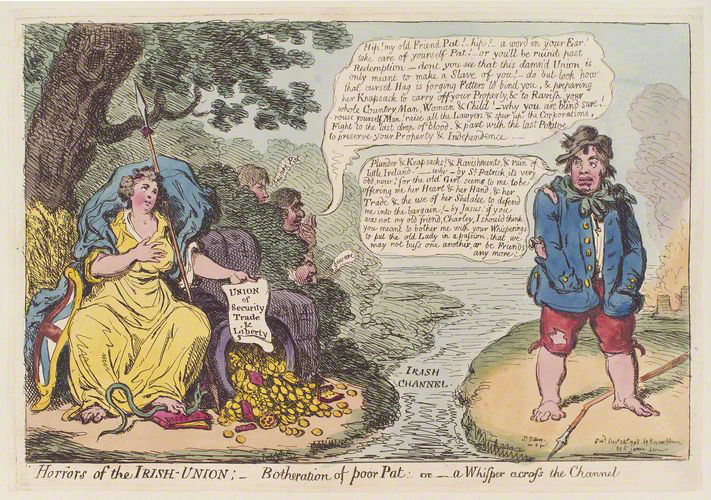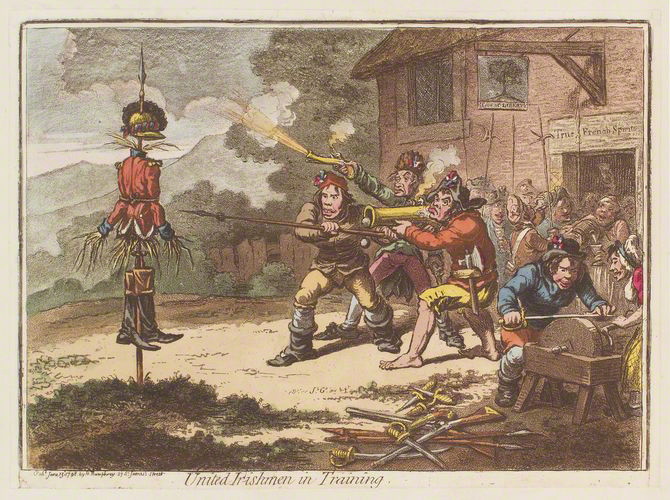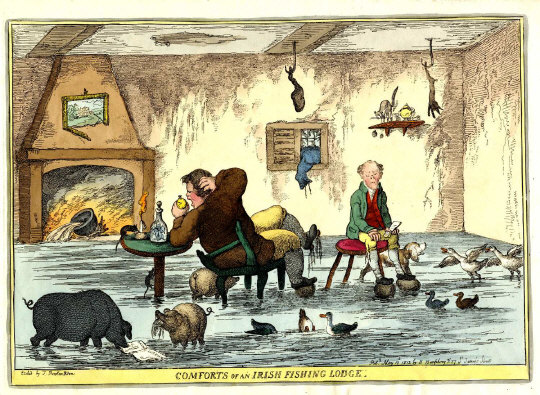In the last few hundred years, dark-skinned peoples have been likened to apes in an effort to dehumanize them and give some form of reasoning behind their oppression and general use . This is not unfamiliar to most Americans as something that is done peculiarly to African Americans The history of American and British discrimination against the Irish, however, offers an interesting study. The Irish, too, have been likened to apes and monkeys, which suggests that this comparison, an invidious comparison to be sure based on Veblen’s theory of status and distinction within the socio-economic realm is a tried-and-true strategy of oppression and subjugation, not one necessarily inspired by the skin color of Africans, but also applicable to more invisible minorities.
The debate took the veneer of pseudo science in Victorian times: whether there had been one creation for all mankind, the creationist monogenism or whether the almighty had completed the work in sections. several efforts: polygenism, before arriving at the ideal corresponding to white gentry and royalty. ”To a large extent, the story of racial science in Britain between 1800 and 1850,” Nancy Stepan wrote, “is the story of desperate efforts to rebut polygenism and the eventual acceptance of popular quasi-polygenist prejudices in the language of science” . The Polygenists and the racists who appropriated the doctrine quickly advocated the disparity of the various creations, and mingled the theory with other Darwinistic permutations of missing links, recessed genes and other fantasies bordering on science fiction as the need arose. All in all, the complicit acceptance of a social acceptance of stereotyping, racial profiling and ghettoization which continues to this day in slightly more subtle form.

Image: http://georgianaduchessofdevonshire.blogspot.com/2010/03/happy-st-patricks-day.html Read More:http://www.fathom.com/feature/122035/index.html ---he source of all evil lies in the race, the Celtic race of Ireland. There is no getting over historical facts ... The race must be forced from the soil; by fair means, if possible; still they must leave. England's safety requires it. I speak not of the justice of the cause; nations must ever act as Machiavelli advised: look to yourself. The Orange club of Ireland is a Saxon confederation for the clearing the land of all papists and jacobites; this means Celts. (Knox, The Races of Men, pp. 253-54.) This is nothing short of a recipe and justification for racial genocide. Knox's book and ideas are such that we are tempted today to dismiss them as the radical quackeries of a racist madman; unfortunately, the frightening reality is that his book (reprinted in 1866) and his theories were among the most respected and influential of the century, helping shape contemporary understandings of race;...
“Bog Trotters” became a long-standing English term for Irish people,especially Irish peasants; near imbeciles, drunks, immoral, frolicking over the countryside. “The workingman’s burden” was another phrase to connote gleeful Irish peasants profiting from Famine relief money on the back of back of , honest exhausted English laborer. ”The Irish Frankenstein” was another stereotype, capitalizing on Mary Shelley’s popular novel, in this case depicting the Irish as savage, mutant humans.Other popular caricatures depicted the Irish as obese,indolent, wasteful, violence prone, drug abusing apes and chimps. Even more insidiously:
…Restriction of the diffusion of technologies and national frontiers do not allow other countries to grow or to make rapid structural changes. Large corporations prevent the flow of technologies, not only to keep other countries backward but to reduce competition. These corporations know that the free export of technology to these countries, whose workers are educated and inexpensive, would weaken their international economic power and comparative advantages. This implies that technological restrictions will create uneven economic development among countries: developed (the center) and underdeveloped countries (the peripheries), a dualistic condition that is compatible with Veblen’s intellectual system. Underdevelopment generates disintegrated and divided countries, which make them easy targets for imperialist expansion. Colonies, mostly from underdeveloped nations, are needed, because “it is reasonably believed that traders and investors in foreign parts are able to derive a large profit from their business when they have the backing of a powerful and aggressive national government; particularly in their dealings with helpless and backward peoples” (Veblen 1919: 131).

Read More:http://www.victorianweb.org/history/race/Racism.html Image:http://georgianaduchessofdevonshire.blogspot.com/2010/03/happy-st-patricks-day.html ---In much of the pseudo-scientific literature of the day the Irish were held to be inferior, an example of a lower evolutionary form, closer to the apes than their "superiors", the Anglo-Saxons . Cartoons in Punch portrayed the Irish as having bestial, ape-like or demonic features and the Irishman, (especially the political radical) was invariably given a long or prognathous jaw, the stigmata to the phrenologists of a lower evolutionary order, degeneracy, or criminality. Thus John Beddoe, who later became the President of the Anthropological Institute (1889-1891), wrote in his Races of Britain (1862) that all men of genius were orthognathous (less prominent jaw bones) while the Irish and the Welsh were prognathous and that the Celt was closely related to Cromagnon man, who, in turn, was linked, according to Beddoe, to the "Africanoid". The position of the Celt in Beddoe's "Index of Nigrescence" was very different from that of the Anglo-Saxon.---
Veblen identified two different behavioral traits in history: the trait of workmanship and the predatory trait (the tendency to exploit and plunder). Workmanship includes such things as parenting and “idle curiosity” in addition to the more usual use of the term – creativity. It is out of this trait that advances in civilization stems. It is also out of this trait from which the instinct for cooperation stems. The predatory instinct is what made early societies revere the strong. The booty from victory at war, including slaves, ears, scalps, etc., were often displayed by the mightiest of warriors. In other systems, the instinct might be less obvious – but it always leads to sexism, racism, subjugation, and exploitation.Read More:http://www.d.umn.edu/~rlichty/Radical%20Lectures/lecture8.pdf
ADDENDUM:
…Curtis’s work has provoked controversy. Sheridan Gilley argued in an essay on ‘English attitudes to the Irish in England, 1780–1900′ that stereotypes about ‘Paddies’ were as much a product of Irish views of themselves as of British prejudice. Moreover, Gilley claimed that such stereotypes were not essentially about race, as Curtis had argued, because most Britons did not regard the Irish as a race apart. For Gilley, British attitudes to the Irish were a complex mixture of the positive and the negative, and derived largely from shifting ideas about religion, class and political violence. Roy Foster endorsed these conclusions in an essay that was published in, and provided the main title for, his collection Paddy and Mr Punch: Connections in Irish and English History (1993). Foster argued that simianisation was but a passing phase in Punch caricatures of the Irish, and that British cartoonists drew upon a much wider range of images of Irish men and women than Curtis had suggested. Foster agreed with Gilley that British attitudes to the Irish were complex and shifting, reflecting not a sense of Irish racial difference, but rather a dislike of popery, peasants and political violence that was expressed in various ways at different times. Foster and Gilley stressed that British attitudes to the Irish could thus only be recovered by situating press comment in its specific, contemporary political context: ‘historians have been right to treat Irish politics as political history.’ Read More:http://www.history.ac.uk/reviews/review/501
————————————————-

Image: http://www.mealys.com/rarebooks/Bidcat/detail.asp?SaleRef=0214&LotRef=318 Read More:http://www.movinghere.org.uk/galleries/histories/irish/settling/racism_prejudice_1.htm ---Liam Greenslade has commented that, "English racism focuses upon colour of skin rather than ethnicity. In this milieu the Irish are literally invisible until they open their mouths". This invisibility was reinforced by the official treatment of Irish citizens in England as if Ireland was still part of the British Isles, an attitude sometimes contrasted with that towards those from Commonwealth countries, and the decision by many Irish people in post-war England "to keep their heads down and their mouths shut". Anti-Irish jokes: Why we're not laughing from the Irish Voice, 1987 Moving Here catalogue reference (HMA) ldbcm2002.81 At times, the fashionable stereotype of Irishness might emphasise a sense of humour, quick-witted repartee, a strong faith and courage. For those simply trying to get on with their lives, labels of comic or eccentric genius can be nearly as tiresome as negative stereotypes.---
In the late l8th centu
nglish historian Arthur Young travelled widely in Ireland. He wrote, “A landlord in Ireland can scarcely invent an order which a laborer, servant, or cottier dares to refuse. He may punish with his cane or horsewhip with most perfect security. A poor man would have his bones broken if he offered to lift a hand in his own defense.”…

Image:http://picturinghistory.gc.cuny.edu/item.php?item_id=211 Read More:http://www.fathom.com/feature/122035/index.html---But it is "the barbarous Celt" who most discomfits Knox: the Celtic race does not, and never could be made to comprehend the meaning of the word liberty ... I appeal to the Saxon men of all countries whether I am right or not in my estimate of the Celtic character. Furious fanaticism; a love of war and disorder; a hatred for order and patient industry; no accumulative habits; restless, treacherous, uncertain: look at Ireland. (Knox, The Races of Men, p. 27.) Once again, such logic leads inevitably to a justification for refusing the Irish the right of self-government: "As a Saxon, I abhor all dynasties, monarchies, and bayonet governments, but this latter seems to be the only one suitable for the Celtic man" (Knox, The Races of Men, p. 27). In asserting that the Irish are the lowest form of "what is called civilized man" ("Civilized man cannot sink lower than at Derrynane"), ---
…When the Irish rebelled in 1798, Britain shipped thousands of chained “traitors” to her penal colonies in Australia. Many Irish prisoners were convinced that the masters of these convict ships were under orders to starve and murder them by neglect on the outward voyage. In The Fatal Shore , Robert Hughes says, “They had reason to think so,” and points to the 1802 arrival of the Hercules, with a 37 percent death rate among the political exiles. That same year, the Atlas II sailed from Cork, with 65 out of 181 “convicts” found dead on arrival. Irish sailors who mutinied to help their countrymen were flogged unmercifully, and “ironed” together with handcuffs, thumbscrews and slave leg bolts. Read More:http://www.eirefirst.com/archive/unit_2.html a

Image:http://www.mealys.com/rarebooks/Bidcat/detail.asp?SaleRef=0214&LotRef=307 Read More:http://www.victorianweb.org/history/race/Racism.html ---following the work of Ernest Renan's La Poésie des Races Celtiques (1854), it was broadly argued that the Celt was poetic, light-hearted and imaginative, highly emotional, playful, passionate, and sentimental. But these were characteristics the Victorians also associated with children. Thus the Irish were "immature" and in need of guidance by others, more highly developed than themselves. Irish "emotion" was contrasted, unfavorably, with English "reason", Irish "femininity" with English "masculine" virtues, Irish "poetic" attributes with English "pragmatism". These were all arguments which conveniently supported British rule in Ireland.---
———————————-
Such complaints grew in currency during the 1830s, but few were as supremacist as Thomas Carlyle’s now infamous attack of 1839:
The wild Milesian features, looking false ingenuity, restlessness, unreason, misery, andmockery, salute you on all highways and byways. The English coachman, as he whirls past, lashes the Milesian with his whip, curses him with his tongue; the Milesian is holding out his hat to beg. He is the sorest evil this country has to strive with. In his rags and laughing savagery, he is there to undertake all work that can be done by mere strength of hand and back – for wages that will purchase him potatoes. He needs only salt for his condiment, he lodges to his mind in any pig-hutch or dog-hutch, roosts in out-houses, and wears a suit of tatters, the getting on and off which is said to be a difficult operation, transacted only in festivals and the high tides of the calendar. The Saxon man, if he cannot work on these terms, finds no work. The uncivilised Irishman, not by his strength, but by the opposite of strength, drives the Saxon native out, takes possession in his room.’ Read More:http://iisresource.org/Documents/KS3_Racism_Interpretation.pdf








 COMMENTS
COMMENTS



